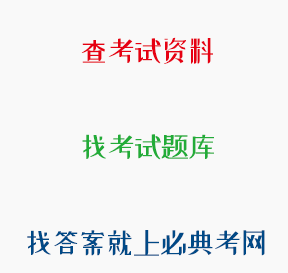正确答案: D
that; what
题目:There is no doubt__________,in my opinion,__________matters is not the speed.but the quality of the product.
解析:本题考查同位语从句及主语从句。句意为“在我看来,毫无疑问,重要的不是速度,而是产品的质量”。in my opinion作插入语。doubt后面是同位语从句,用that连接,说明doubt的内容。在同位语从句中is前面的部分是主语从句,缺少主语,用what连接。故本题选D。
查看原题 查看所有试题
学习资料的答案和解析:
[单选题]张磊发现,在检查自己昨晚的试卷和作业时,很难发现其中的错误,但帮别的同学检查时,却很容易发现,这主要是由于( )的影响。
定势
解析:定势指由先前影响所形成的往往不被意识到的心理准备状态,它将支配人以同样的方式去对待同类后继活动。故本题选D。
[单选题]某中学校长对素质教育检查组说:“我们学校对素质教育十分重视,课外活动开展得丰富多彩,有科技小组、美术小组、音乐小组……但现在学生正在上课,下午课外活动时,请你们指导。”该校长对素质教育的理解
不正确,素质教育不等于课外活动
解析:素质教育是依据人的发展和社会发展的需要,以全面提高全体学生的基本素质为根本目的,以尊重学生主体性和主动精神,注重开发人的智慧潜能,形成人的健全个性为根本特征的教育。学校可以从以下方面来实施素质教育:学校管理;课外、校外教育活动;中小学班主任工作;教师业务水平。课外、校外教育只是实施素质教育的途径之一,但是素质教育并不等于课外活动。题干中,校长错误地把素质教育认为是课外活动,是不正确的,所以此题选A。
[单选题]针对一块园地,园艺师们提出了如下建议:(1)牡丹、芍药至多种植一种;(2)如果种植芍药,则不能种植蝴蝶兰或者玫瑰;(3)牡丹、玫瑰至少种植一种。实际种植时,上述三条建议只有一条被采纳。根据以上陈述,以下最可能符合实际种植情况的是( )。
牡丹、芍药和玫瑰均种
解析:这是一道真假话推理的题目。因为上述三条建议只有一条被采纳,意味着在正确的选项下,三句话只有一句话为真,那么我们可以分别对四个选项进行假设,结果如下:A项,(1)×,(2)×,(3)√;B项,(1)√,(2)√,(3)×;C项,(1)√,(2)×,(3)√;D项,(1)√,(2)√,(3)×。故选择A项。
[单选题]找规律填数字是一种很有趣的游戏,特别锻炼观察与思考能力,下列各组数字填入数列"1、3、7、13、23、_、_107空缺处,正确的是( )。
39、65
解析:前两位数之和加3得到后一位数:13+23+3=39:23+39+3=65。
[单选题]柏拉图认为,应该为国家统治者的教育开设众多实用性的教学科目,其中他最为重视的是( )。
哲学
解析:柏拉图的著作《理想国》中最高的教育目标是培养哲学家兼政治家一一哲学王。柏拉图、为哲学家的教育开列了众多的教育科目,包括阅读、书写、体育、军事、哲学、算术、几何学、天文学、音乐理论。在所有科目中,柏拉图最为重视的是哲学(辩证法)。
[单选题] There is nothing like the suggestion of a cancer risk to scare a parent, especially one of the over- educated, eco-conscious type. So you can imagine the reaction when a recent USA Today investigation of air quality around the nation's schools singled out those in the smugly green village of Berkeley, Calif, as being among the worst in the country, The city's public high school, as well as a number of daycare centers, preschools, elementary and middle schools, fell in the lowest 10%. Industrial pollution in our town had supposedly tumed students into living science experiments breathing in a laboratory's worth of heavy metals like manganese(锰), chromium(铬) and nickel(镍) each day. This is a city that requires school cafeterias to serve organic meals. Great, I thought, organic lunch, toxic campus.
Since December, when the report came out, the mayor, neighborhood activists and various parent- teacher associations have engaged in a fierce battle over its validity: over the guilt of the steel-casting factory on the western edge of town, over union jobs versus children's health and over what, if anything, ought to be done. With all sides presenting their own experts armed with conflicting scientific studies, whom should parents believe? Is there truly a threat here, we asked one another as we dropped off our kids, and if so, how great is it? And how does it compare with the other, seemingly perpetual health scares we confront, like panic over lead in synthetic athletic fields? Rather than just another weird episode in the town that brought you protesting environmentalists, tlus latest drama is a trial for how today's parents perceive risk, how we try to keep our kids safe-whether it's possible to keep them safe-in what feels like an increasingly threatening world. It raises the question of what, in our time,"safe" could even mean.
"There's no way around the uncertainty," says Kimberly Thompson,president of Kid Risk, a nonprofit group that studies children's health."That means your choices can matter, but it also means you aren't going to know if they do." A 2004 report in the journal Pediatrics explained that nervous parents have more to fear from fire, car accidents and drowning than from toxic chemical exposure. To which I say: Well, obviously. But such concrete hazards are beside the point. It's the dangers parents can't-and may never- quantify that occur all of sudden. That's why I've rid my cupboard of microwave food packed in bags coated with a potential cancer-causing substance, but although I've lived blocks from a major fault line (地质断层) for more than 12 years, I still haven't bolted our bookcases to the living room wall.
The investigation by USA Today revealed that ________.
the air around Berkeley's school campuses is polluted
解析:1.细节题。文中第二段提到“…whom should parents believe?”可见家长对调查结果也很不确信,故选C。
2.细节题。USA Today的调查结果显示air quality around the nation's schools singled out those in the smugly green village of Berkeley,Calif.,as being among the worst in the country,即空气污染严重,故选C。
3.细节题。文中第二段第一句提到“Since December,when the report came out,the mayor, neighborhood activists and various parent-teacher associations have engaged in afierce battle over its validity…”即引起了激烈的争论,故选D。
4.细节题。文中最后一段提到“But such concrete hazards are beside the point”,故选项 A和C不符合题意;选项D不是Pediatrics的研究;第三句提到“…that nervous parents have more to fear from fire,car accidents and drowning than from toxic chemical exposure”,所以选B.
5.态度题。从最后一段可以判断,作者觉得更可怕的是那些不可以确定的事物;选项 C是其中一个方面,不够全面。故选A。
[多选题]下列说法正确的是( )。
墨子主张"兼爱"
孔子重视"仁""礼"的思想
解析:荀子主张性恶论,孟子主张性善论,墨子主张兼爱非攻,孔于思想的核心是仁、礼。
[单选题]小学后期、初中时期学生的学习动机是( )。
获得赞赏
解析:奥苏泊尔提出内驱动力,并将其分为认知内驱力、附属内驱力、自我提高内驱力。附属内驱力指个人为了保持长者们或权威们的赞许或认可.而表现出来的一种把学习或工作做好的需要。对于学生来说,附属的内驱力表现为,学生为了赢得家长或教师的认可或赞许而努力学习,取得好成绩的需要,附属的内驱力有比较明显的年龄特征。在年龄较小的儿童身上,附属的内驱力是成就动机的主要成分。随着儿童年龄的增长和独立性的增强,附属的内驱力不仅在强度上有所减弱,而且在附属对象上也从家长和教师转移到同伴身上。在青少年时期,来自同伴的赞许或认可将成为一个强有力的动机因素。小学初期的附属内驱力主要表现为为了获得家长或老师的表扬或奖励,小学后期及初中期,主要来自同伴的赞许或认可。

 川公网安备 51012202001360号
川公网安备 51012202001360号